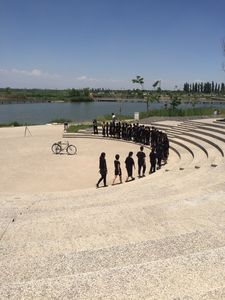Tis the season to be… at art biennales and fairs. June saw the opening of four biennales: the 10th Berlin Biennale on June 8; the second Yinchuan Biennale in China on June 9 and Manifesta, the European biennale, in Palermo, Italy, on June 16. Not to mention the place where everybody worth his salt in the art world will be flocking to—Art Basel, the mother of all art fairs.
I was thrilled to watch the second edition of the Yinchuan Biennale, which opened in Museum of Contemporary Art (MoCA), Yinchuan. I could be reasonably proud of it, as I curated the first edition in 2016. That gave me the unique opportunity to familiarise myself with Yinchuan, the capital of the Ningxia Hui Autonomous Region. Flanked by the Yellow River in the east and the Helan Mountains in the west, the region is serene and scenic. This landscape has influenced the architecture of MoCA.
This year's Yinchuan Biennale has new commissions alongside ancient artistic relics from public museums and private collections. The participating artists have been selected from over 30 countries, with particular attention being paid to the western borders of China (from Mongolia to central and southeast Asia) in a way that is consistent with the exhibition’s geopolitical and investigative methods. The title of the biennale, 'Starting from the Desert - Ecologies on the Edge', was apt for the works from 80 groups (92 individuals) of artists. These were displayed within the museum, the International Artists Village, and the Hui Nongqu Eco-Park.
The concept put together by chief curator Marco Scotini and his team—Andris Brinkmanis, Paolo Caffoni, Lu Xinghua and Zasha Colah (from India)—was daunting in its scope, yet thought provoking in the end. It had a reasonably good Indian representation with Ravi Agarwal, Navjot Altaf with Rajkumar Korram and Shantibai Vishwakarma, Sheba Chhachhi, Nikhil Chopra, Shiva Gor, Prabhakar Pachpute, u-ra-mi-li (Iswar Srikumar and Anushka Meenakshi), and Justin Ponmany.
Justin never refrains from springing surprises with his art projects. This time, I had the chance to see his choreographed and theatrical performance, a first for me. His project has been put together with the help of local theatre students and faculty. Using an outdoor amphitheatre with the landscape—a Chinese metaphor [for the well-regulated state]—as backdrop and a bicycle as prop with mimicked birdsong, the performance was at once mesmerising, persuasive and meditative. There was another performance by the compelling Nikhil Chopra—his live drawings alluding to nomadic nature.
My Yinchuan MoCA team was thrilled to see me back. It was really nice to hear most of them say, “We remember you a lot and miss you,” which immediately transported me to the days I spent there with my small team—Jessal Thacker, Mithika Mathew, the unpredictable maverick Manoj Nair, the lovely Rebecca, Julia and others. Su Chen, then artistic director of MoCA, who had invited me to curate the inaugural biennale, has moved on to other pastures and been replaced by Professor Lu Peng.
But setting up a biennale is as exacting as it is exciting. Thinking about a new biennale itself is a risk with inherent questions like, is it possible; where are the sites; who will run it; who is the audience; who will fund it; how many artists; how many days and finally who is going to ensure quality and consistency. And, Yinchuan is a distant and diffident place to run both a museum and a contemporary art biennale.
Yet, I was struck by the diversity of the works on display at Yinchuan. The works of Shiva Shreshta from Nepal, Mariam Ghani from Afghanistan, Kim Sooja from Korea and many others were impressive. However, what I left Yinchuan with was the image of a fantastic carpet, an arte povera work by the legend, Alighiero Boetti.
editor@theweek.in


